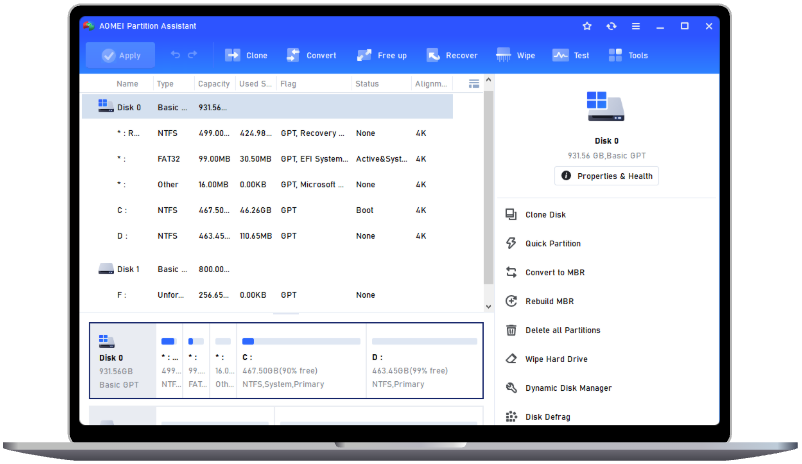How to Choose an SSD-to-USB Converter?
SSDs have become a popular storage option due to their high speed and reliability. However, there are times when you need to access an SSD externally. This is where an SSD-to-USB converter comes in handy. In this guide, will explain everything you need to know about selecting an SSD-to-USB converter and show you how to transfer data to an SSD.
What is an SSD-to-USB converter?
An SSD-to-USB converter also refers to an SSD-to-USB adapter or enclosure. It allows you to connect an internal SSD via a USB port to a computer. These devices make it easy to access data on SSDs without installing them inside a computer. You may need it in the following situations:
➤ Access the data on an SSD without installing it internally on a computer.
➤ Clone or back up data from an SSD to another drive.
➤ Expand your device’s storage capacity.
➤ Transfer large amounts of data between devices.
➤ Recover data from a dead computer.
Common types of SSD to USB converters
There are different types of SSD to USB converters depending on the type of SSD you have, including:
● SATA to USB Converters: Used for 2.5-inch SATA SSDs.
● M.2 SATA to USB Converters: Designed for M.2 SATA SSDs.
● NVMe to USB Converters: Used for M.2 NVMe SSDs, which offer higher speeds than SATA SSDs.
● U.2 to USB Converters: Less common, used for enterprise-grade SSDs.
What should we consider when choosing an SSD-to-USB converter?
When choosing a suitable SSD to USB converter, there are several factors you should consider, including compatibility, data transfer speeds and build quality. By carefully evaluating these aspects, you can select a converter that best suits your needs.
1. Compatibility
To make sure the converter works properly, it’s essential to check if it is compatible with your SSD. For example, if you are using a 2.5-inch SATA SSD, choose a SATA to USB adapter or enclosure. For M.2 SSDs, you need to check if it uses SATA or NVMe. NVMe SSDs need a special NVMe to USB adapter.
2. USB Interface and Speed
The speed of data transfer depends on the USB interface of the converter. You can choose a suitable one according to your needs:
● USB 2.0 – Slow (about 480 Mbps). It is not recommended unless you have no other option.
● USB 3.0 – Good for general use (about 5 Gbps). Ideal for SATA SSDs.
● USB 3.1 Gen 2 – Faster speeds (about 10 Gbps). Ideal for NVMe SSDs.
● USB 3.2 or USB 4.0 – High-speed (about 20 Gbps or higher). Best for high-performance SSDs.
3. Build Quality and Design
The quality of the converter is important, especially if you use it often. Metal enclosures help with heat dissipation. Plastic adapters are lighter but may not last as long. Also, tool-free designs make installation and removal easier. Converters with vents and heat sinks help reduce overheating.
4. Power Supply
Most 2.5-inch SATA SSDs can be powered via USB, but 3.5-inch HDDs and U.2 SSDs may require an external power source. Ensure your converter can provide adequate power for your SSD type.
5. Additional Features
● UASP (USB Attached SCSI Protocol): Increases transfer speed and lowers CPU usage.
● TRIM Support: Keeps SSD performance stable over time.
● Plug-and-Play: Works without installing extra drivers.
● Data Cloning and Backup: Some adapters have built-in software for easy cloning.
Recommended SSD to USB Converters
SATA to USB Converters
✔️UGREEN SATA to USB 3.0 Adapter – Budget-friendly, easy to use, supports UASP.
✔️StarTech USB 3.1 to 2.5” SATA Adapter – Fast speed, supports UASP.
✔️ORICO 2.5” SATA SSD Enclosure – Tool-free, good for portable storage.
M.2 NVMe to USB Converters
✔️Sabrent NVMe to USB 3.2 Enclosure – 10Gbps speed, aluminum case.
✔️ORICO M.2 NVMe to USB-C Adapter – Small size, fast data transfer.
✔️ICY DOCK M.2 NVMe to USB Enclosure – Strong cooling, durable build.
M.2 SATA to USB Converters
✔️UGREEN M.2 SATA SSD Enclosure – 6Gbps speed, tool-free setup.
✔️FIDECO M.2 SATA to USB Adapter – Works with different M.2 sizes.
Pro Tips: How to Transfer Data to an SSD?
After connecting your SSD to your device, you can take various actions depending on your needs. One of the most common tasks is cloning data from an old drive to another one. By doing so, you can create an exact copy of your drive, migrate the OS, or replace your old drive.
While numerous tools are available for cloning, AOMEI Partition Assistant stands out for its user-friendly interface and advanced cloning technology, which works seamlessly with both SSDs and HDDs. This software enables you to clone an entire disk or just a single partition without losing any data. It is compatible with Windows 11, 10, 8/8.1, and 7.
Why Choose AOMEI Partition Assistant?
★ Fast Disk Cloning: You can even clone a larger disk to a smaller one with ease.
★ Sector-by-Sector Cloning: Supports clones only in the used sectors, saving disk space and skipping bad sectors.
★ High Compatibility: Supports cloning for all brands of SSDs and HDDs.
★ OS Migration: Allows you to clone only the OS partition to an SSD and successfully boot from the cloned drive after migration.
Here’s how to clone SSDs using AOMEI Partition Assistant:
Step 1. Connect an SSD to your computer via a suitable converter first. If the SSD is new, initialize it before proceeding.
Step 2. Launch AOMEI Partition Assistant, click "Clone" in the main interface, and select "Clone Disk".
Step 3. Choose the SSD you need to clone as the source disk and click "Next".
Step 4. Select the destination disk to store the data on the source disk, and then click "Next".
Step 5. Then, check the source and destination disk in the next window.
Here, you can also click the "Settings" button to adjust the partition size on the destination disk. But if you choose the “Sector to Sector clone” mode, the partition size cannot be adjusted.
Step 6. Finally, click "Apply" and "Proceed" to start the cloning process.
Conclusion
Choosing the right SSD-to-USB converter depends on factors such as your SSD type, required speed, and additional features. This guide covers everything you need to know to make an informed decision when selecting an SSD-to-USB converter.
Additionally, we recommend a powerful tool for drive cloning: AOMEI Partition Assistant. It also offers a range of disk management features, including creating/deleting partitions, allocating free space, and converting disks between MBR and GPT. Download it today to enhance your storage management experience!


